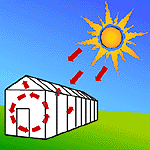14. CO2 and water vapor in the atmosphere help maintain the earth’s surface temperature in a few ways. During the day, when the sun’s rays beam down, the gas molecules block and adsorb a majority of the radiation, preventing the temperature on Earth from reaching high levels. During the night, the heat adsorbed by the gases in the morning is released; keeping the temperature up and not letting it get too cold.
15. Natural processes and human activity:
a. Natural: the carbon cycle. Human: burning waste.
b. Natural: cow matter. Human: raising livestock and refining fossil fuels.
16. Composition of atmosphere:
a. A lower concentration of greenhouse gases would cause the earth’s temperature to increase.
b. An increase of gas molecules would decrease the temperature of Earth because fewer radiation rays would reach the surface.
17. A greenhouse would be warmer than a structure with opaque wooden walls because the radiation waves that enter the greenhouse cannot escape, but the ones inside the wooden walls can.
18. Greenhouse effect:
a. A greenhouse:
b. The global greenhouse:
19. Chemical reservoirs of carbon include carbon dioxide, limestone, solid calcium carbonate, and methane.
20. Carbon atoms follow the carbon cycle, which takes them through all parts of the Earth. When carbon is released as carbon dioxide it enter the atmosphere. After being received by plants for respiration, it is now in the form of glucose and enters the hydrosphere in that form, or as carbon dioxide. The oxygen that is released by plants is inhaled by humans and exhaled as carbon dioxide (making it a part of the biosphere). It is eventually inhaled by underwater plants, or formed into limestone, which eventually decays and returns to the lithosphere.



No comments:
Post a Comment